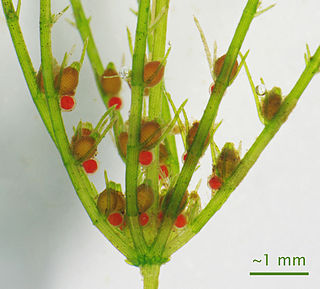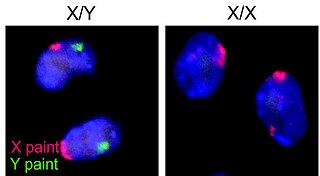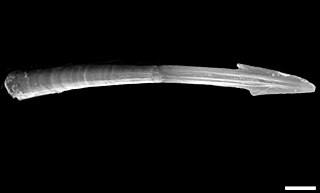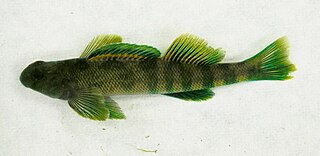Related Research Articles

A sex organ, also known as a reproductive organ, is a part of an organism that is involved in sexual reproduction. Sex organs constitute the primary sex characteristics of an organism. Sex organs are responsible for producing and transporting gametes, as well as facilitating fertilization and supporting the development and birth of offspring. Sex organs are found in many species of animals and plants, with their features varying depending on the species.

Fish anatomy is the study of the form or morphology of fish. It can be contrasted with fish physiology, which is the study of how the component parts of fish function together in the living fish. In practice, fish anatomy and fish physiology complement each other, the former dealing with the structure of a fish, its organs or component parts and how they are put together, such as might be observed on the dissecting table or under the microscope, and the latter dealing with how those components function together in living fish.

A cloaca, pl.: cloacae, or vent, is the rear orifice that serves as the only opening for the digestive, reproductive, and urinary tracts of many vertebrate animals. All amphibians, reptiles, birds, and a few mammals have this orifice, from which they excrete both urine and feces; this is in contrast to most placental mammals, which have two or three separate orifices for evacuation and reproduction. Excretory openings with analogous purpose in some invertebrates are also sometimes called cloacae. Mating through the cloaca is called cloacal copulation and cloacal kissing.
Papilla or papillae may refer to:

Internal fertilization is the union of an egg and sperm cell during sexual reproduction inside the female body. Internal fertilization, unlike its counterpart, external fertilization, brings more control to the female with reproduction. For internal fertilization to happen there needs to be a method for the male to introduce the sperm into the female's reproductive tract.

Fish reproductive organs include testes and ovaries. In most species, gonads are paired organs of similar size, which can be partially or totally fused. There may also be a range of secondary organs that increase reproductive fitness. The genital papilla is a small, fleshy tube behind the anus in some fishes, from which the sperm or eggs are released; the sex of a fish can often be determined by the shape of its papilla.
In biology, polyspermy describes the fertilization of an egg by more than one sperm. Diploid organisms normally contain two copies of each chromosome, one from each parent. The cell resulting from polyspermy, on the other hand, contains three or more copies of each chromosome—one from the egg and one each from multiple sperm. Usually, the result is an unviable zygote. This may occur because sperm are too efficient at reaching and fertilizing eggs due to the selective pressures of sperm competition. Such a situation is often deleterious to the female: in other words, the male–male competition among sperm spills over to create sexual conflict.
This glossary of ichthyology is a list of definitions of terms and concepts used in ichthyology, the study of fishes.

The longspine snipefish, bellowfish, common bellowsfish, snipe-fish, snipefish, spine trumpet fish, or trumpetfish, Macroramphosus scolopax, is a snipefish of the genus Macroramphosus. It is also known as the slender snipefish off the South African coast.
Breitensteinia is a genus of catfishes of the family Akysidae. It includes three species.

Acrochordonichthys is a genus of catfishes of the family Akysidae. It includes ten species.

Microsynodontis is a genus of upside-down catfishes native to freshwater rivers in western Africa. The genus was originally described by British-Belgian zoologist George Albert Boulenger in 1903 based upon the type species Microsynodontis batesii. The name microsynodontis comes from the Greek word mikro, meaning small, and the Greek term synodon, meaning "with the teeth all growing together".

A love dart is a sharp, calcareous or chitinous dart which some hermaphroditic land snails and slugs create. Love darts are both formed and stored internally in a dart sac. These darts are made in sexually mature animals only, and are used as part of the sequence of events during courtship, before actual mating takes place. Darts are quite large compared to the size of the animal: in the case of the semi-slug genus Parmarion, the length of a dart can be up to one fifth that of the semi-slug's foot.
The reproductive system of an organism, also known as the genital system, is the biological system made up of all the anatomical organs involved in sexual reproduction. Many non-living substances such as fluids, hormones, and pheromones are also important accessories to the reproductive system. Unlike most organ systems, the sexes of differentiated species often have significant differences. These differences allow for a combination of genetic material between two individuals, which allows for the possibility of greater genetic fitness of the offspring.

An organism's sex is female if it produces the ovum, the type of gamete that fuses with the male gamete during sexual reproduction.

The reproductive system of gastropods varies greatly from one group to another within this very large and diverse taxonomic class of animals. Their reproductive strategies also vary greatly.
An intromittent organ is any external organ of a male organism that is specialized to deliver sperm during copulation. Intromittent organs are found most often in terrestrial species, as most non-mammalian aquatic species fertilize their eggs externally, although there are exceptions. For many species in the animal kingdom, the male intromittent organ is a hallmark characteristic of internal fertilization.
Pseudogobiopsis is a genus of fish in the goby family, Gobiidae. They are native to fresh and brackish waters of southern and southeastern Asia. The genus is mainly distinguished by the number and arrangement of fin rays and spines, headpores, and sensory papillae, the large mouths of the males, a fleshy or bony flange on the pectoral girdle, and the shape of the genital papilla.

The reproductive system of planarians is broadly similar among different families, although the associated structures can vary in complexity.

Etheostomatinae is a species-rich subfamily of freshwater ray-finned fish, the members of which are commonly known as the darters. The subfamily is part of the family Percidae which also includes the perches, ruffes and pikeperches. The family is endemic to North America. It consists of three to five different genera and well over 200 species. A common name for these fish in southern Indiana is pollywog.
References
- ↑ Laboratory Manual for General Biology 5th Edition
- ↑ Barrie G M Jamieson (12 September 2019). Reproductive Biology and Phylogeny of Fishes, Vol 8B: Part B: Sperm Competition Hormones. CRC Press. ISBN 978-1-4398-4358-1.